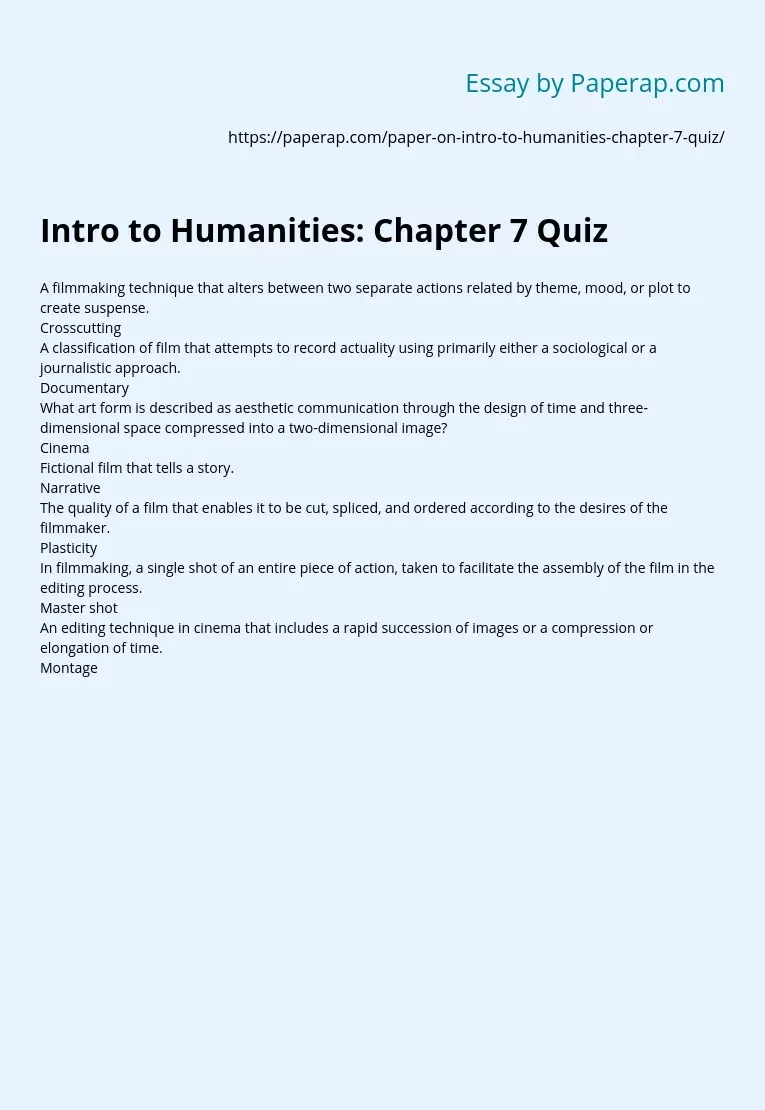Intro to Humanities: Chapter 7 Quiz
Topics:
Film Analysis
Essay,
Pages 2 (456 words)
Views
243
A filmmaking technique that alters between two separate actions related by theme, mood, or plot to create suspense.
Crosscutting
A classification of film that attempts to record actuality using primarily either a sociological or a journalistic approach.
Documentary
What art form is described as aesthetic communication through the design of time and three-dimensional space compressed into a two-dimensional image?
Cinema
Fictional film that tells a story.
Narrative
The quality of a film that enables it to be cut, spliced, and ordered according to the desires of the filmmaker.
Plasticity
In filmmaking, a single shot of an entire piece of action, taken to facilitate the assembly of the film in the editing process.
Master shot
An editing technique in cinema that includes a rapid succession of images or a compression or elongation of time.
Montage
What type of camera shot is seen in the above clip?
Close up
In film, this term refers to how the visual materials are staged, framed, and photographed.
Mise-en-scene
A filmmaking method to draw attention in which the actors look or talk into the camera.
Direct address
Which term below BEST identifies the editing technique seen in the above clip?
Jump cut
In filmmaking, a form of optical transition in which an invisible line moves across the screen, eliminating one shot and revealing the next.
Wipe
A transitional device in filmmaking created by closing or opening the aperture of the camera lens.
Iris in/iris out
According to this theory, whoever controls the mise-en-scene is the true author of the film.
Auteur
Sergei M. Eisenstein’s film Battleship Potemkin is one of the most influential films ever made due in part because it added this new dimension to film language:
Montage editing
In cinema, this camera viewpoint is roughly analogous to the third-person narrative in literature.
Objective
In film, this person serves the function of converting the mise-en-scene from three-dimensional to two-dimensional space.
Director
According to Louis Giannetti, this term refers to the voyeuristic aspect of cinema.
The gaze
A technique of editing that breaks the continuity of time by moving forward from one part of the action to another.
Jump cut
The viewpoint in filmmaking in which the scene unfolds as if the audience were actually participating in it.
Subjective
A filmmaking technique in which natural or outdoor lighting is used and the camera is hand-held, while the film appears unsteady.
Cinema-verite
In filmmaking when the main object of interest stays clear while the remainder of the scene blurs of focus.
Rack
In filmmaking, the camera rotates horizontally while keeping it fixed vertically.
Pan
Which term below BEST identifies the editing technique seen in the above clip?
Montage
What type of camera shot is seen in the above clip?
Extreme long shot
Intro to Humanities: Chapter 7 Quiz. (2018, Jan 26). Retrieved from https://paperap.com/paper-on-intro-to-humanities-chapter-7-quiz/

